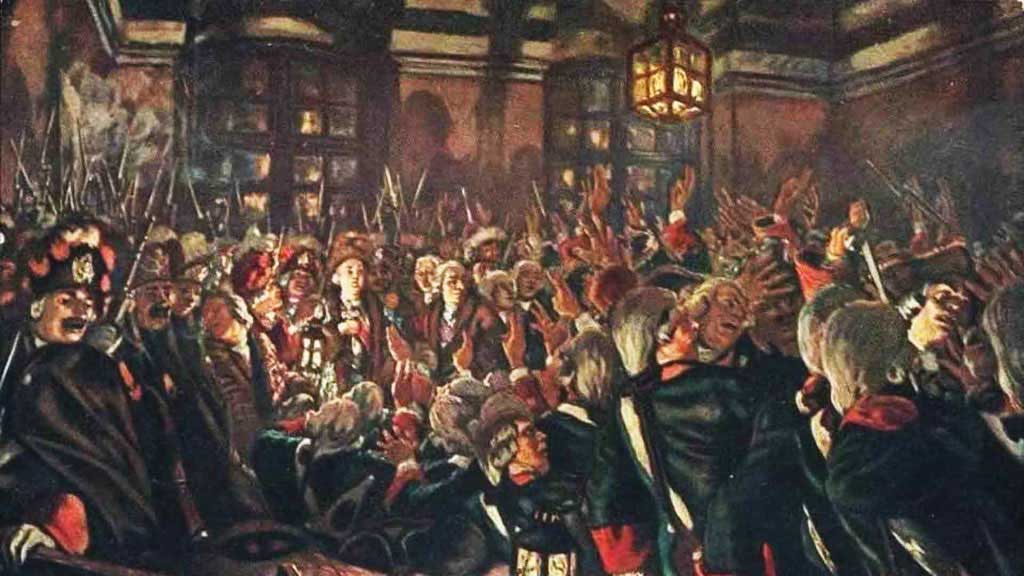1725-1762
The period between Peter the Great and Catherine the Great is called the Era of Palace Revolutions. During that “second time of troubles” Russia was mostly ruled by women, and power was always seized by force.

“The Preobrazhensky Regiment Soldiers Proclaim Elizabeth the Empress of Russia” by Yevgeny Lanceray (1913)
Background
When Peter the Great died in 1725, he did not name an heir. He had 13 children with two wives. Only 3 of them survived. Peter himself had beaten his oldest son Alexey to death because Peter was disappointed in him.
Female rulers
Eighteenth-century Russia was dominated by women. Most of the rulers seized power with a coup and had their predecessor murdered.
In 1725 Peter the Great’s wife Catherine I seized power for two years. State matters were left to her ally Alexander Menshikov.
Following young Peter II’s death of smallpox, tsarina Anna Ivanovna was elected to rule by the nobility. Her Baltic-German ally Ernst von Biron angered people with his luxurious lifestyle.
Anna had no children and she left her adopted infant child Ivan VI to rule with regent Anna Leopoldovna.
The opportunity was seized by Peter the Great’s daughter Elizabeth, who took the throne with the help of her father’s Guards regiments.
Conclusion
During that period the Guards had major role in the balance of power at the court. Without their support rulers had little ability to stay on the throne.
Palace Revolutions
1725-1762
The period between Peter the Great and Catherine the Great is called the Era of Palace Revolutions. During that “second time of troubles” Russia was mostly ruled by women, and power was always seized by force.
“The Preobrazhensky Regiment Soldiers Proclaim Elizabeth the Empress of Russia” by Yevgeny Lanceray (1913)
Background
When Peter the Great died in 1725, he did not name an heir. He had 13 children with two wives. Only 3 of them survived. Peter himself had beaten his oldest son Alexey to death because Peter was disappointed in him.
Female rulers
Eighteenth-century Russia was dominated by women. Most of the rulers seized power with a coup and had their predecessor murdered.
In 1725 Peter the Great’s wife Catherine I seized power for two years. State matters were left to her ally Alexander Menshikov.
Following young Peter II’s death of smallpox, tsarina Anna Ivanovna was elected to rule by the nobility. Her Baltic-German ally Ernst von Biron angered people with his luxurious lifestyle.
Anna had no children and she left her adopted infant child Ivan VI to rule with regent Anna Leopoldovna.
The opportunity was seized by Peter the Great’s daughter Elizabeth, who took the throne with the help of her father’s Guards regiments.
Conclusion
During that period the Guards had major role in the balance of power at the court. Without their support rulers had little ability to stay on the throne.
Catherine I